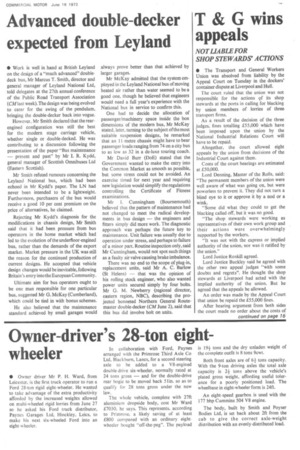Advanced double-decker expected from Leyland
Page 15

If you've noticed an error in this article please click here to report it so we can fix it.
• Work is well in hand at British Leyland on the design of a "much advanced" doubledeck bus, Mr Marcus T. Smith, director and general manager of Leyland National Ltd, told delegates at the 27th annual conference of the Public Road Transport Association (CM last week). The design was being evolved to cater for the swing of the pendulum, bringing the double-decker back into vogue.
However, Mr Smith declared that the rearengined configuration was still the best for the modern stage carriage vehicle, whether single or double-decked. He was contributing to a discussion following the presentation of the paper "Bus maintenance — present and past" by Mr I. R. Kydd, general manager of Scottish Omnibuses Ltd (Eastern Scottish).
Mr Smith refuted rumours concerning the Leyland National bus, which had been echoed in Mr Kydd's paper. The LN had never been intended to be a lightweight. Furthermore, purchasers of the bus would receive a good 10 per cent premium on the price of alternatives, he claimed.
Rejecting Mr Kydd's diagnosis for the modifications in chassis design, Mr Smith said that it had been pressure from bus operators in the home market which had led to the evolution of the underfloor-engined bus, rather than the demands of the export market. Market pressure in the UK was still the reason for the continued production of current designs. He accepted that vehicle design changes would be inevitable, following Britain's entry into the European Community.
Ultimate aim for bus operators ought to be one man responsible for one particular bus, suggested Mr G. McKay (Cumberland), which could be tied in with bonus schemes.
He also believed that the maintenance standard achieved by small garages would always prove better than that achieved by larger garages.
Mr McKay admitted that the system employed in the Leyland National bus of moving heated air rather than water seemed to be a good one, though he believed that engineers would need a full year's experience with the National bus in service to confirm this.
One had to decide the allocation of passenger/machinery space inside the box dimensions of the modern bus, Mr McKay stated, later, turning to the subject ofthe most suitable suspension designs, he remarked that an 11-metre chassis might have to bear passenger loads ranging from 74 on a city bus to as low as 32 in a de-luxe touring coach.
Mr David Burr (DoE) stated that the Government wanted to make the entry into the Common Market as smooth as possible, but some stress could not be avoided. An exercise timed for next year and requiring new legislation would simplify the regulations controlling the Certificate of Fitness examinations.
Mr I. Cunningham (Bournemouth) believed that the pattern of maintenance had not changed to meet the radical developments in bus design — the engineers and fitters simply did more work. The diagnostic approach was perhaps the future key to maintenance. Unit failure was usually due to operation under stress, and perhaps to failure of a minor part. Routine inspection only, said Mr Cunningham, would not spot such things as a faulty air valve causing brake imbalance.
There was no end to the scope of plug-in, replacement units, said Mr A. C. Barlow (St Helens) — that was the opinion of his rolling stock engineer, who also wanted power units secured simply by four bolts. Mr G. M. Newberry (regional director, eastern region, NBC), describing the projected bonneted Northern General Routemaster double-decker (CM June 2), said that this bus did involve bolt on units.




























































































